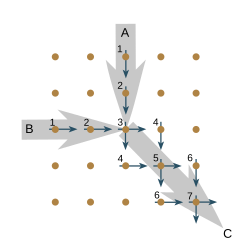Calculating Space

Calculating Space (German: Rechnender Raum) is Konrad Zuse's 1969 book on automata theory. He proposed that all processes in the universe are computational.[2] This view is known today as the simulation hypothesis, digital philosophy, digital physics or pancomputationalism.[3] Zuse proposed that the universe is being computed by some sort of cellular automaton or other discrete computing machinery,[2] challenging the long-held view that some physical laws are continuous by nature. He focused on cellular automata as a possible substrate of the computation, and pointed out that the classical notions of entropy and its growth do not make sense in deterministically computed universes. Zuse's thesis was later expanded by German computer scientist Jürgen Schmidhuber in his book Algorithmic Theories of Everything.[4]
See also[]
References[]
- ^ Rechnender Raum (PDF document), Elektronische Datenverarbeitung, 8: 336–344, 1967.
- ^ Jump up to: a b Mainzer, Klaus; Chua, Leon (September 2011). The Universe as Automaton: From Simplicity and Symmetry to Complexity. Springer. p. 6.
- ^ Müller, Vincent. "Pancomputationalism: Theory or Metaphor?". Philosophy, computing and information science: 213–221.
- ^ Jürgen Schmidhuber (2000-12-20). Algorithmic Theories of Everything (PDF).
- Konrad Zuse, 1969. Rechnender Raum. Braunschweig: Friedrich Vieweg & Sohn. 70 pp.
- --------, 1970. "Calculating Space", MIT Technical Translation AZT-70-164-GEMIT, Massachusetts Institute of Technology (Project MAC), Cambridge, Mass. 02139. Adrian German and Hector Zenil (eds) re-edition in LaTeX with permission of MIT and Zuse's family, 2012
- Jürgen Alex: Rechnender Raum, in: Drsb.: Zur Entstehung des Computers - Von Alfred Tarski zu Konrad Zuse [ ... ] - Tertium non datur, VDI-Verlag Düsseldorf 2007, SS. 251 bis 279, ISBN 978-3-18-150051-4
External links[]
- Jürgen Schmidhuber's site Zuse's book and 1967 paper.
- Calculating Space - a painting by Zuse - Konrad Zuse's visualization of the idea
- Web article and simulation of such a calculating space in C and LIBPNG GERMAN
- SecondSpace Simulation of waves within a 2D space (time and space are discrete), similar to FDTD. An OpenCL graphic card is needed.
- Theoretical computer science
- Konrad Zuse
- 1969 non-fiction books
- Physics books
- Cellular automata
- Physics book stubs